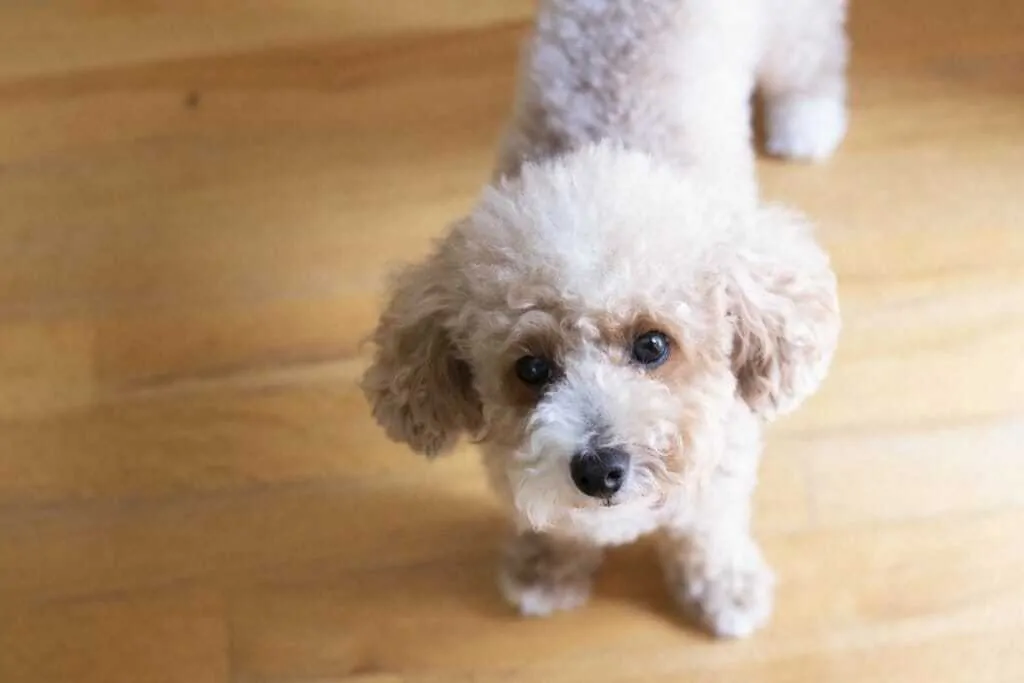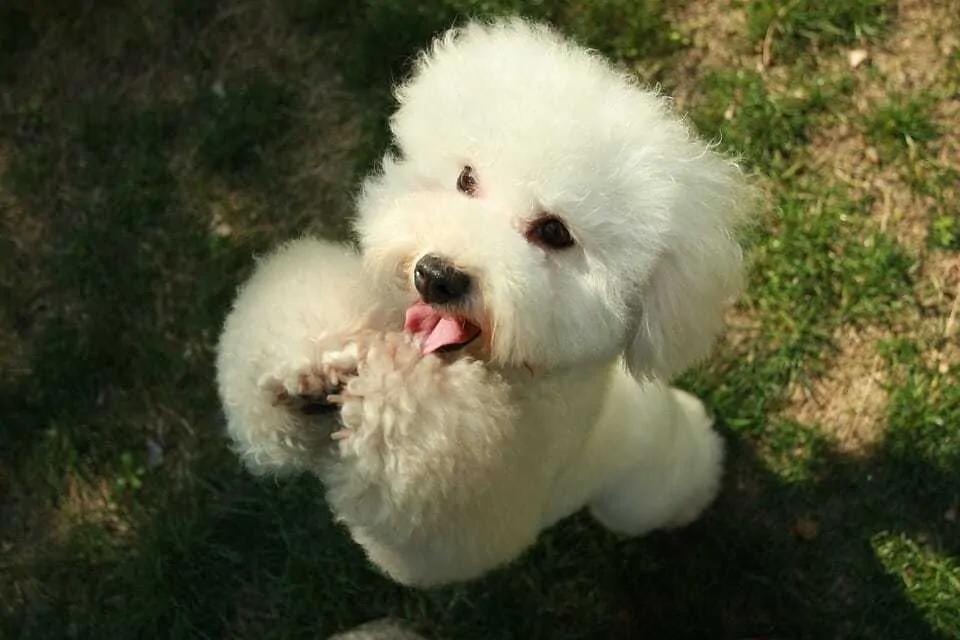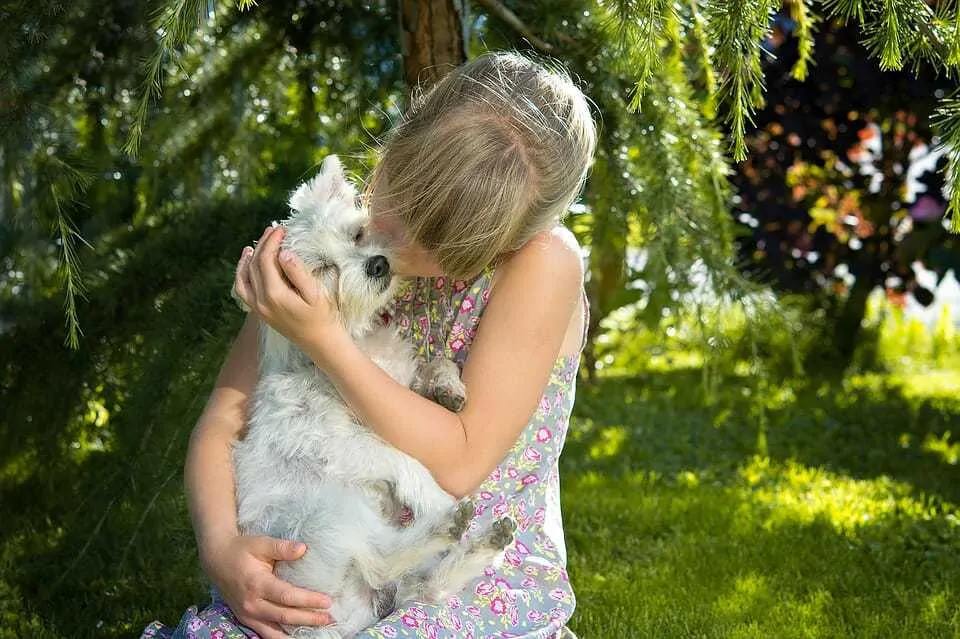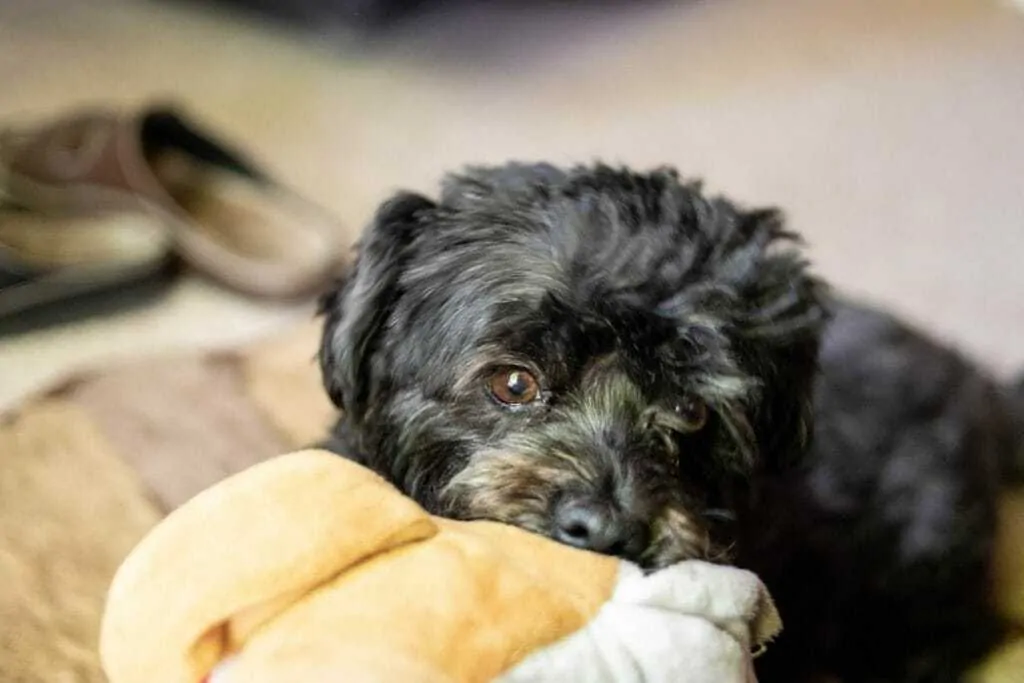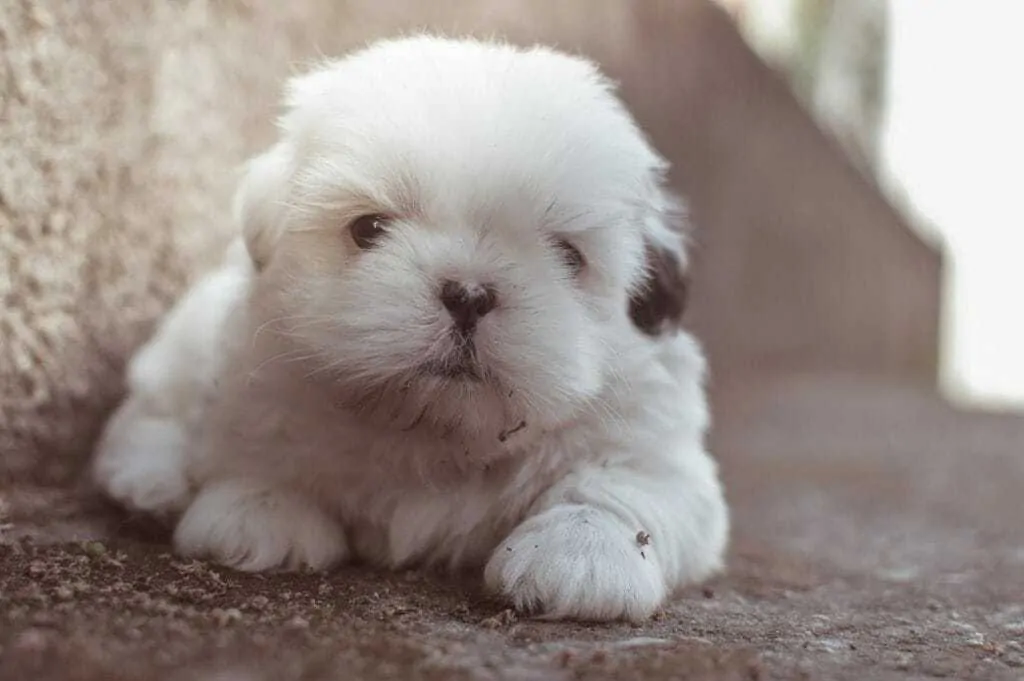Okay, I’m going to write this article and try to be as unbiased as possible, which is going to be difficult as I am the very proud parent of an adorable six-pound Maltipoo female.
In my mind, my curly-haired cutie is the most precious thing to have ever graced the planet. She is sweet, mischievous, funny, and insanely adorable. And now that all my gushing is out of the way, let’s get real.
Just because I’m head over heels in love with my Maltipoo doesn’t mean this is the dog for everyone. And while Maltipoo dogs are still not considered their own breed, per say, they do have certain characteristics, temperamental traits, and health issues that perspective Maltipoo owners should be aware of before committing to owning and raising one.
Curious about if the Maltipoo would be right for your family? Then keep reading! I’m going to share with you my humble opinions on this mixed breed as well as some breed-specific facts to help you decide if you should call a Maltipoo your own.
Let’s begin!
Contents
What Is A Malti-Poo?
A Maltipoo is a crossbreed, aka designer dog, aka a mixed breed, aka a hybrid.
There is some controversy surrounding crossbreeding and whether or not these types of dog breeds should be considered mutts, breeds, or mixes, and there is also some debate over whether crossbreed dogs are actually healthier than purebreds.
Unfortunately, the verdict is still out so I’m not able to provide you with any clear and definitive answers on the subject. The arguments surrounding crossbreeding are quite fascinating, however, and I encourage you to look into them if you have the time.
Maltipoo = Poodle and Maltese Mix
A Maltipoo is a cross between the purebred Poodle and the purebred Maltese. If you have a first-generation Maltipoo, then you have the direct offspring of the two.
If you have a second or third generation Maltipoo, then both parents are mixes between the two purebred dogs themselves.
What do I have? I have a second-generation Maltipoo. This means that my dog’s mom and dad are also both Maltipoos, but that her grandparents are purebred Poodle and purebred Maltese.
Ahh, genetics. Isn’t it fun?
Well, it can be, but it can also be a little confusing, especially when it comes to crossbreeds.
The reason is that while some of the controversy surrounding crossbreed dogs has to do with health and proper naming, it also has to do with predictability.
Dog breeding, and even crossbreeding, are ancient practices that have been around for centuries. When you get a purebred dog, you are generally able to have an idea of what that dog is going to look like.
If you get a standard Poodle, for example, you know you are going to get a dog of a certain color, hair texture, size, and temperament.
With a mixed breed or mutt, things can be a bit more complicated. Let’s learn more.
What Does A Maltipoo Look Like?
Since your Maltipoo is going to be a cross between two different purebred breeds, knowing for sure what he is going to look like is impossible.
Even mixed breed puppies of the same litter can grow up looking quite different from one another.
This means your Maltipoo could grow up with the very tight curls of a Poodle or the long, wavy hair of a Maltese. He could also have hair that is somewhere in between like my dog has.
Maltipoos can vary in size and appearance.
The coloring and size of your Maltipoo are also going to be left up to chance and genetics.
You see, while the purebred Maltese is a white dog, Poodles come in several different shades including black, white, apricot, cream, sable, black and white, silver, brown, grey, and even blue.
Your Maltipoo could be any of these colors or even a mix of different colors depending on his parents and his genetics.
However, one thing we can guesstimate is that your Maltipoo will be on the smaller side. Most Maltipoo dogs are bred to be smaller, meaning that Maltese, who are between six and nine pounds, are typically bred with toy or miniature teacup Poodles of around the same size and weight.
Also, since both the Maltese and the Poodle are considered hypoallergenic, the Maltipoo is a great mixed breed dog for those who suffer from allergies.
What is A Malti-Poo Temperament Like?
While the temperament of a dog has a lot to do with how it is raised, socialized, and bred, it also has a lot to do with the dog’s genetics.
For centuries now, dogs of different breeds have been bred for different purposes. In this case, your Maltipoo, who is the offspring of two different breeds bred for different purposes, could have a few different personality traits that will be left up to chance.
For the most part, Maltipoos are friendly dogs.
For the most part, they are friendly, sweet, outgoing, and playful. They love to snuggle, and make for great therapy dogs.
These are dogs who won’t do well being left home alone for too often and have been known to suffer from separation anxiety and depression if not properly socialized, exercised, and mentally stimulated.
They need regular walks and exercise, although their smaller size means walks can be short and brisk, and they will require plenty of love and training.
And while these dogs do well with children and other household pets when properly socialized and introduced properly, they are small which puts them at more of a risk of getting hurt or injured.
But what other temperamental traits could your dog have?
To better understand the temperament of a Maltipoo and the different characteristics he could inherit from his parents, we’ll need to take a look at his genetics.
Keep reading.
Purebred Maltese Temperament
Since it is half Maltese, it’s important to understand what the Maltese was bred for and what it’s typical temperament is.
If you are considering one for your home, you’re in luck. Maltese, in particular, were originally bred as companion dogs to royalty nearly 28 centuries ago. Their name derives from the island of Malta just off the Mediterranean sea.
Maltese dogs were bred for companionship over 28 centuries ago!
These dogs were the devoted companions of royalty and are used to sitting on laps and being adored. If you are looking for a snuggly companion who will love nothing more than cuddling, then perhaps a dog who has some Maltese in him is the way to go.
Of course, keep in mind that your Maltipoo also has some Poodle genetics mixed in, and Poodles weren’t just bred as companion dogs for royalty.
Ready to learn about the feistier side? Let’s talk about the temperament of the purebred Poodle!
Purebred Poodle Temperament
Poodles may be just as playful and loving as their Maltipoo counterparts, but they are also a bit more energetic and have more on their minds.
These dogs were originally bred as hunting companions in Germany and were eventually used as water retrieving dogs in France.
Due to their intelligence, playful personalities, and willingness to please, Poodles played many roles throughout history!
Because of their doggy intelligence and knack for pleasing their human counterparts, Poodles quickly rose to fame as circus and street performers.
Over the years, Poodles were bred down in size so they could be better suited as tiny living fashion accessories and lap dogs for nobles in France.
Today, Poodles come in three sizes including standard, toy, and teacup. However, regardless of if they are standing at their largest or can fit into a handbag, the Poodle maintains his energy and intelligence.
Poodles are energetic and highly active and require lots of mental stimulation and exercise to stay happy and healthy, which means your dog will probably need the same type of care.
Are Malti-Poo Dogs Good With Children and Other Pets?
Maltipoo dogs are excellent dogs for families with older children who are respectful and gentle.
Like all dogs, Maltipoos will need to be properly socialized and children should be taught how to handle these dogs gently.
One thing I should mention is that Poodles especially have a very high prey drive, so while your dog will likely get along with dogs and cats, he may be driven to chase smaller pets like hamsters, birds, and rats.
Maltipoos are great dogs for families with older children.
Regardless of your dog’s breed or crossbreed, I always recommend that dogs are trained consistently throughout their lifetime starting at an early age. Dogs should also be repeatedly socialized so they can maintain a happy and healthy lifestyle and mental state.
When training your Maltipoo, remember that this is a crossbreed who aims to please so punishment should be avoided.
Always use positive reinforcement methods when training your dog such as treats and praise as opposed to scolding.
They are quick learners who love their families and want nothing more than to make them happy and be with them.
However, using punishment during training could cause your dog to regress and may even hurt the bond between the two of you, so be careful.
How Long Do Maltipoo Dogs Live – Typical Lifespan
Your Maltipoo could live anywhere between the lifespan of his parent breeds. Poodles, for example, live anywhere from 14 to 18 years while Maltese dogs live between 12 to 15 years.
Your Maltipoo’s lifespan will depend on his genetics, amongst other things.
Maltipoo Health Issues
The good news is that both Poodles and Maltese breeds are relatively healthy dogs, so you don’t have much to worry about in the way of genetic health issues.
The most common health issues for Miniature and Toy Poodles include
Collapsed Trachea
Legg-Calve-Perthes Disease
And skin issues including hair loss
The most common health issues for Maltese dogs include
Dental issues including tooth loss
Portosystemic shunts
Eye issues
Patellar luxation
And Hydrocephalus
Be aware that your Maltipoo could inherit any number of the same health issues prone to his parent breeds.
You should also be aware that smaller dogs can be more prone to dental issues and eye problems, including eye gunk, discharge, and irritation. They can also be prone to tracheal collapse, which is why it is especially important to walk your Maltipoo on a harness when dog walking as opposed to using his collar and leash.
Smaller dogs like Maltipoos can also be at a higher risk of injury, as I mentioned above, due to their small and more fragile size.
Teach children how to handle dogs gently and supervise your Maltipoo around larger household pets who may play with them a bit too roughly.
You can further help to keep your Maltipoo healthy and happy by making sure he maintains a healthy diet and gets proper exercise and mental stimulation.
Keeping up with routine vet visits and maintaining proper grooming practices with your Maltipoo will also assist in keeping him in ship-shape so that he may live his best and happiest life with you.
How Much Do Maltipoo Dogs Cost?
I remember the first time I told my dad how much I spent on my Maltipoo. I swear he about passed out.
“You spent how much on a mutt?” He cried.
Well, in my defense, she isn’t a mutt. She is a hybrid dog, a designer dog, a mixed breed if you will. Not a mutt. There’s a difference.
But is there really?
Well, this is part of the crossbreed controversy. Why are breeders selling mixed breeds for just as much as purebred dogs when there is still so much we don’t know about them? Is it fair? And does it matter?
Despite being considered by some to be mutts, Maltipoos can be pretty expensive.
While I can’t answer all of these questions for you, I can tell you that if you have your heart set on buying a Maltipoo from a breeder, prepare to spend a pretty penny.
Maltipoo pups range in cost from anywhere between $400 to $2,000 depending on the quality of the breeder, the quality of the puppy’s parents, the puppy’s estimated size and coloring, etc.
However, if you choose to adopt a Maltipoo from a rescue or a shelter, you’re going to be looking at paying a fraction of the price.
In fact, rescues typically cost around $50 to $150 and you may even get a vet exam thrown in for free!
I love rescues and have to admit there is nothing better than adopting a dog in need.
With that being said, I want to encourage you to do your research and be careful, regardless of the avenue you choose to take when getting your Maltipoo.
Remember, there are many sources online offering Maltipoos and other designer and purebred dogs for much less than the price I listed. Be aware of these online sellers and backyard breeders, and never ever buy a puppy from a pet store as you are risking supporting puppy mills.
When going through a breeder to get your Maltipoo, make sure you do your research and remember that any reputable breeder will be able to offer health certifications proving that their puppies have been health screened and tested for any genetic or health issues.
Is A Malti-Poo The Right Choice for My Home?
Let’s summarize, shall we?
Maltipoos are basically the greatest creation of dog kind in my most unbiased opinion. With that being said, they are not for every person or family.
Before you commit to getting a Maltipoo, consider your family and lifestyle. Remember that Maltipoo dogs are small and fragile and won’t do well in homes with very young toddlers and small children who play roughly.
Maltipoo dogs are also very family oriented and will need to spend a good amount of time with their people. They can be prone to separation anxiety and depression if left alone for too long.
However, if you do have a busy or unpredictable schedule, you may still be able to get a Maltipoo so long as you arrange for a dog walker or pet care specialist to stop by during the times you are away.
With proper training and socialization, Maltipoos make good family dogs.
Maltipoo dogs are, by all accounts, great with children and other pets but they may have a strong prey drive and desire to chase smaller animals.
This is a dog who is not meant to be outdoors either, and is the safest and happiest inside the house with his family.
The Maltipoo is a great option for families who are both active or more go-with-the-flow, since this dog enjoys many different activities and he knows how to be playful or relaxed depending on the situation.
Maltipoos are also considered to be hypoallergenic, which is a fancy way of saying they shed less and produce less allergy-inducing dander than many other breeds, so these are great dogs for families who suffer with allergies.
Are you considering getting a Maltipoo? Tell us what you love about the Maltipoo in the comments below!

Madison Guthrie (also known as Sonny Mackenzi) is a pet care specialist and positive-reinforcement trainer who works most closely with anxious and reactive dogs. Born and raised in Littleton, Colorado, Madison developed a love for animals at an early age and spent most of her childhood outdoors rescuing stray pets and helping to rehabilitate injured wildlife. Along with animals, Madison also developed a love for writing and music. Over the past five years, she has worked to use her passions to help the pets and pet parents in her community build stronger bonds and live happier, healthier lives together. Currently, Madison lives in South Pasadena, California where she owns and operates Miss Madison LLC, a marketing company that focuses on helping privately owned veterinary establishments and pet care companies grow and thrive. She also works as a dog trainer at My Dog Spot, which is an award-winning pet care and training establishment in Pasadena, California.
